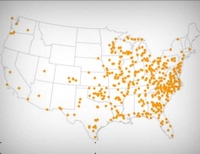University of Texas Student Calls Out the Census’ Counting of Incarcerated People as Residents of their Prison as a Violation of State Law
Counting incarcerated people at prison facilities defies common sense and the Texas Election Code.
by Dan Kopf, July 20, 2016
In July 2015, University of Texas at Austin graduate student Rachel Gandy submitted a comment letter to the U.S. Census Bureau to express her frustration with the Bureau’s policy of counting incarcerated people as residents of their prison facility, rather than as residents of their hometown.
Gandy explains that not only does this practice defy “common sense”, it also disregards Texas law. She point to this statement in the Texas Election Code:
In this code, ‘residence’ means domicile, that is, one’s home and fixed place of habitation to which one intends to return after any temporary absence… A person who is an inmate in a penal institution… does not, while an inmate, acquire residence at the place where the institution is located.
Because the Census’ practice of including incarcerated people as residents of their prison runs counter to the Election Code, many Texan leaders must spend time fixing these counts, to avoid distorting democracy within their county or school board.
Gandy writes:
The Census Bureau’s Residence Rule ignores Texas law, so community leaders have had to take this problem into their own hands. In an investigation of jurisdictions with large prison populations, researchers found that almost all (86%) Texas communities rejected prison gerrymandering by excluding prisoners from population counts, even if the vote dilution impacts of including prisoners were miniscule. In some parts of the state, the effects of using uncorrected Census Bureau data would have been far from innocuous.
Though many community leaders have been able to obtain the correct counts on the local level, at the state level Texas still relies on Census data for districting. Since African Americans and Latinos are overrepresented in Texas’s prisons, and these facilities are often located in rural white areas, this has the important impact of diluting the political power of African-American and Latino communities.
Gandy is not alone in finding this policy untolerable. Many other organizations and individuals have called out the Census Bureau for choosing to count incarcerated people in a manner that harms communities and is in violation of the “one person, one vote” principle. Nonetheless, the Census Bureau proposes to continue to count incarcerated people in a way that conflicts with the Texas Election Code, conflicts with the need of African-American and Latino communities for fair representation, and conflicts with the common sense desire of the rural Texas communities that host prisons. All of these factors, Gandy writes, call for a change in how the Census Bureau counts incarcerated people.



